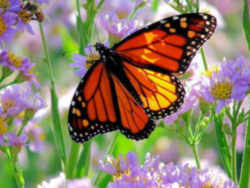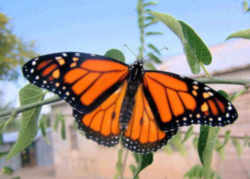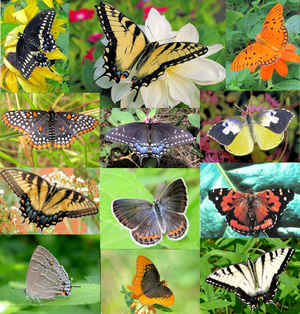
West Virginia Symbols
West Virginia State Butterfly
Monarch Butterfly

(Danaus plexippus)
Adopted on March 1, 1995.
The monarch butterfly, (Danaus plexippus,) was declared the official state butterfly of West Virginia by Senate Concurrent Resolution No. 11, adopted by the Legislature on March 1, 1995 noting that the monarch butterfly is one of the most beautiful butterflies in the region; and the monarch butterfly exists in abundance in West Virginia.
Did you know that: The Monarch Butterfly has been proclaimed the official state insect or butterfly in each of the following states:
Alabama | Idaho | Illinois | Minnesota
Texas | Vermont | West Virginia
West Virginia State Butterfly: Monarch Butterfly

The monarch butterfly is sometimes called the "milkweed butterfly" because its larvae eat the plant. In fact, milkweed is the only thing the larvae can eat! If you'd like to attract monarchs to your garden, you can try planting milkweed (if you live in the right area).
Entomologists divide the migrating populations of Monarch Butterflies into two groups, one west of the continental divide which is considered too high for the butterflies to fly over, and all the territory eastward including Florida. The eastern and western migrating Monarch undergoes a chemical change delaying sexual maturity, allowing the butterflies to wait out the winter in large colonies south of the freeze line which have been found in Mexico and California. They only mate when they return north, living as long as nine months in the process.
Characteristics of the Monarch Butterfly
In Spring when the female butterflies migrate northward, they lay eggs on various species of milkweed. The development period from the egg through larva and chrysalis to the adult ranges from 20 to 33 days. The development time depends on temperature (faster in warmer areas). Some monarchs remain in the vicinity of their breeding grounds; others fly north to lay eggs. Some monarchs remain in the vicinity of their breeding grounds; others fly north to lay eggs.
The development period from the egg through larva and chrysalis to the adult ranges from 20 to 33 days. The development time depends on temperature (faster in warmer areas).
The larvae feed on the plant leaves for about two weeks and develop into caterpillars about 2 inches long.
After awhile, the caterpillars attach themselves head down to a convenient twig, they shed their outer skin and begin the transformation into a
pupa (or chrysalis), a process which is completed in a matter of hours.
The pupa resembles a waxy, jade vase and becomes increasingly transparent as the process progresses. The caterpillar completes the miraculous transformation
into a beautiful adult butterfly in about two weeks.
The butterfly finally emerges from the now transparent chrysalis.
It inflates its wings with a pool of blood it has stored in its abdomen. When this is done, the monarch expels any excess fluid and rests.
The butterfly waits until its wings stiffen and dry before it flies away to start the cycle of life all over again.
Eastern populations winter in Florida, along the coast of Texas, and in Mexico, and return to the north in spring. Monarch butterflies follow the same migration patterns every year. During migration, huge numbers of butterflies can be seen gathered together.
Most predators have learned that the monarch butterfly makes a poisonous snack. The toxins from the monarch's milkweed diet have given the butterfly this defense. In either the caterpillar or butterfly stage the monarch needs no camouflage because it takes in toxins from the milkweed and is poisonous to predators. Many animals advertise their poisonous nature with bright colors... just like the monarch!
West Virginia SENATE CONCURRENT RESOLUTION NO. 11
SENATE CONCURRENT RESOLUTION NO. 11
(By Senators Schoonover, Anderson, Scott, Buckalew,
Bailey, Manchin, Love, Whitlow, Helmick and Ross)
Declaring the monarch butterfly as the official state butterfly of West Virginia.
Whereas, West Virginia does not have an official state butterfly; and
Whereas, The monarch butterfly is one of the most beautiful butterflies in the region; and
Whereas, The monarch butterfly exists in abundance in West Virginia; therefore, be it
Resolved by the Legislature of West Virginia:
That the monarch butterfly is hereby declared the official butterfly of West Virginia; and, be it
Further Resolved, That the Clerk of the Senate is hereby requested to forward a copy of this resolution to the governor.
West Virginia Law
The monarch butterfly was designated the official butterfly of the State of West Virginia by Senate Concurrent Resolution No. 11, adopted by the Legislature on March 1, 1995. Because the butterfly was adopted by resolution, it is not a part of the West Virginia Code.
Taxonomic Hierarchy: Monarch Butterfly
Kingdom: Animalia (Animals)
Phylum: Arthropoda (Arthropods)
Subphylum: Hexapoda (Hexapods)
Class: Insecta (Insects)
Order: Lepidoptera (Butterflies and Moths)
Superfamily: Papilionoidea (Butterflies and Skippers)
Family: Nymphalidae (Brush-footed Butterflies)
Subfamily: Danainae (Milkweed Butterflies & Glasswings)
Tribe: Danaini (Milkweed Butterflies)
Genus: Danaus
Species: plexippus (Monarch - Hodges#4614)
Butterflies, and Bugs







